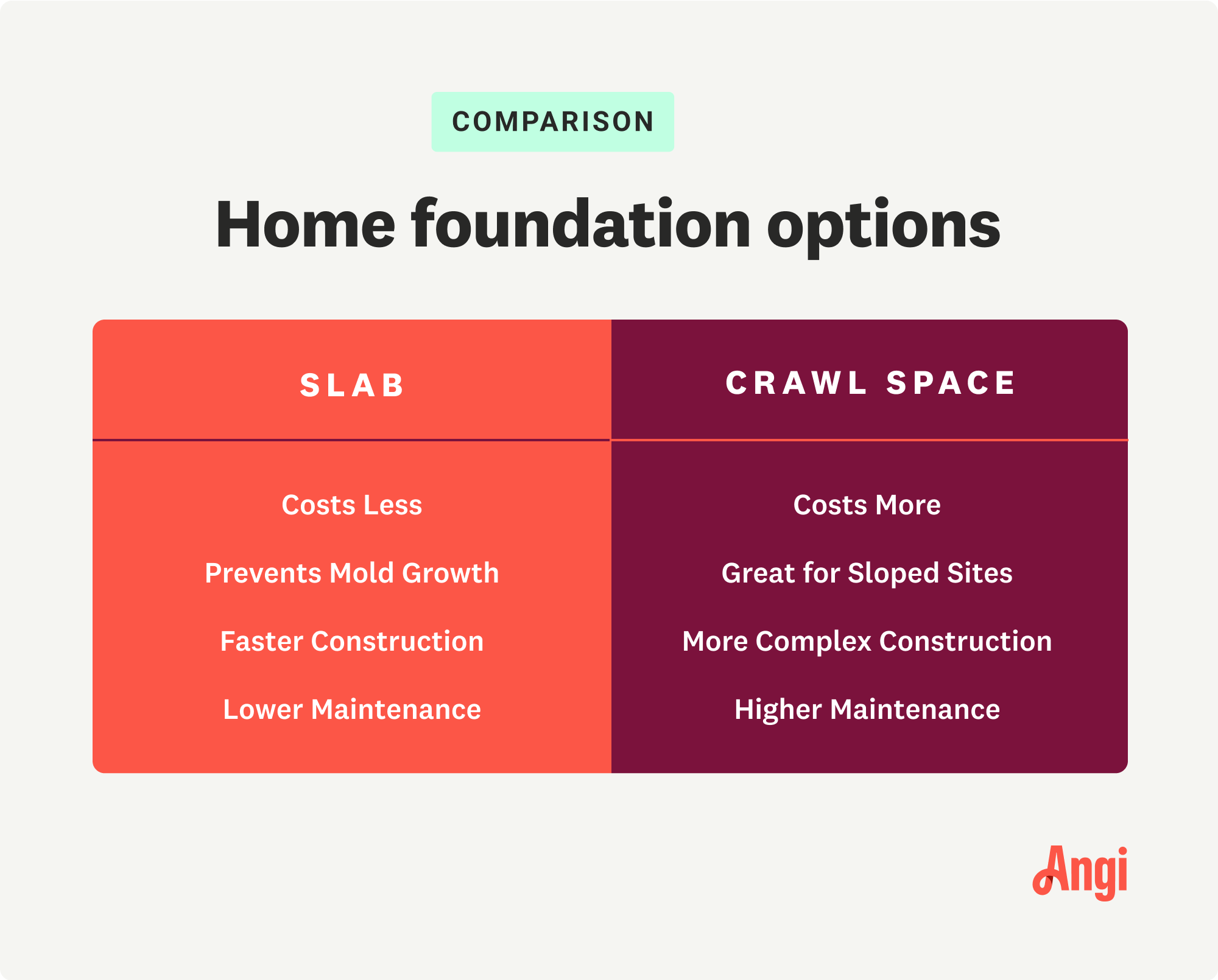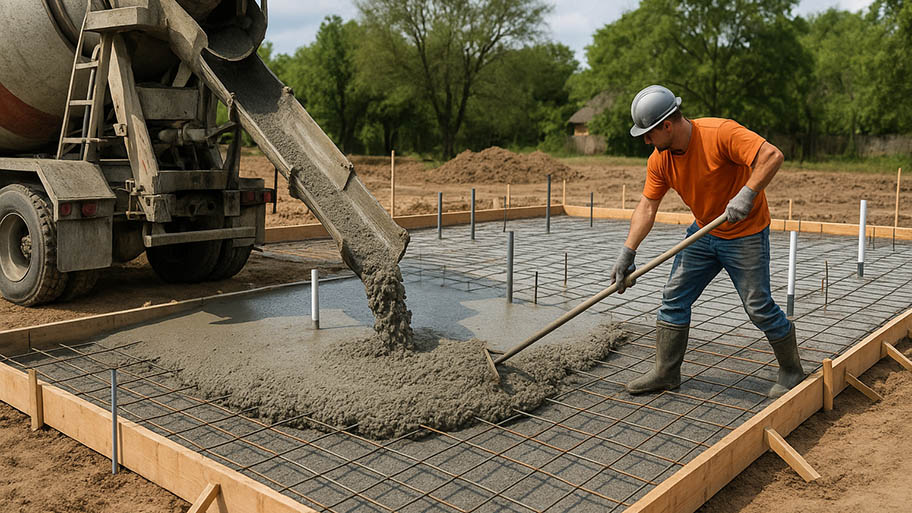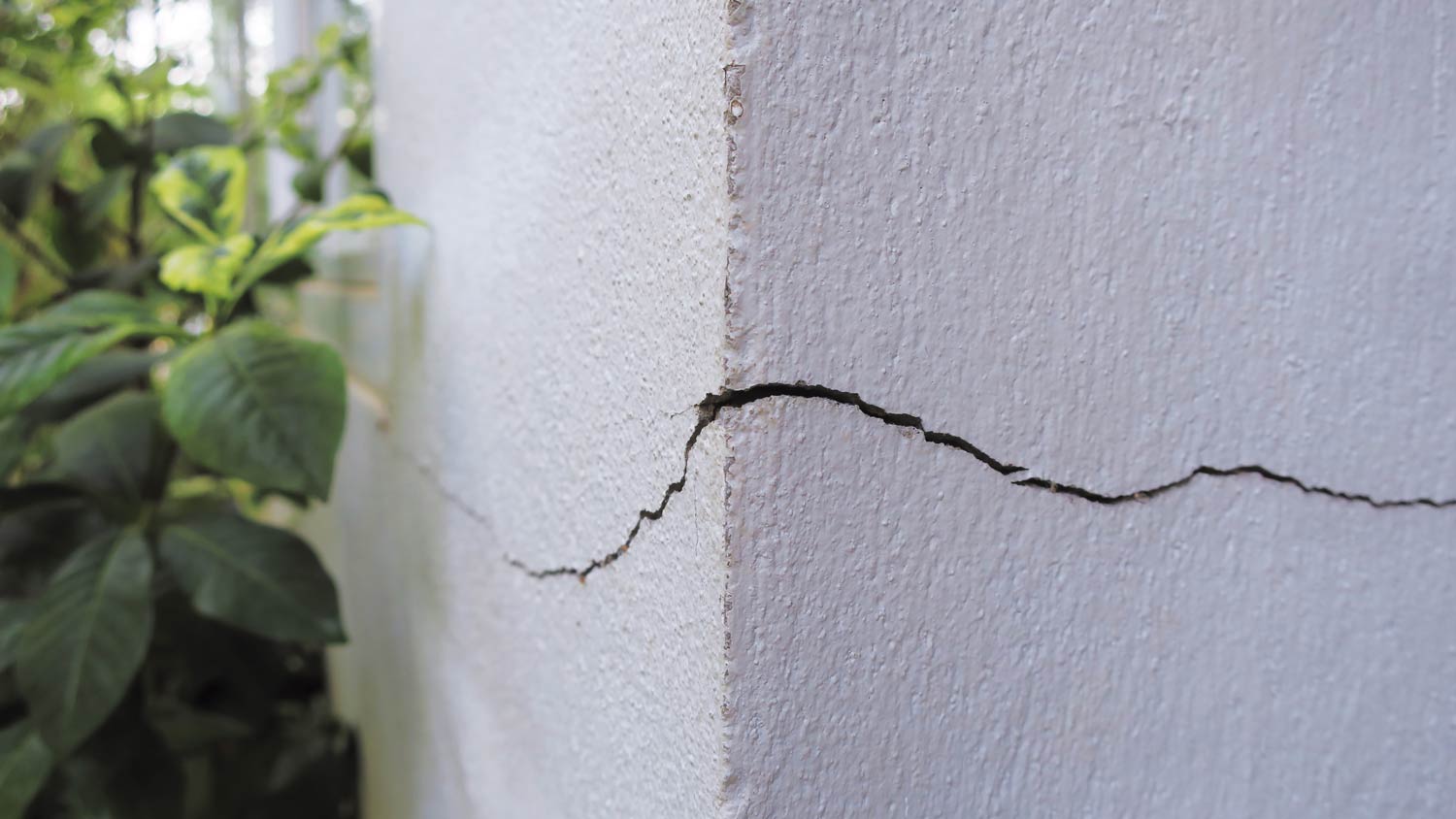
Crawl space maintenance can help improve indoor air quality and avoid structural damage. Learn how much crawl space cleaning costs and when to schedule it.
Slabs are more affordable, but crawl spaces offer more convenience and utility


Slabs are more affordable and better for moist climates.
Crawl spaces provide more utility but are more expensive.
The depth of the frost line is the main factor that drives foundation styles.
Slabs versus crawl spaces are two of the most popular types of foundations for a home, and each is better suited for different climates and local weather conditions. Choosing the foundation that’s right for your home–and will add the most value–requires that you understand the differences and advantages of each. In this guide, we’ll explain slab versus crawl space foundations and take a look at the advantages, disadvantages, and cost differences of each one.
Slab and crawl space foundations are two of the most popular options for home foundations. Their key differences come from how they are built. Crawl space foundations have exterior concrete walls that raise the home’s foundation above ground level, while slab foundations sit directly on the ground beneath the home. Crawl space foundations are less durable than slab foundations, but they’re good choices for areas prone to earthquakes.

Slab foundations consist of a solid slab of concrete either sitting directly on the ground—called a floating slab foundation—or sitting on footings that sink deeper into the ground below the frost line. Utility lines can run through the slab, but since there’s no underhome area, there’s no space for water heaters or other major utility components, which means they will take up some living space.
Slabs are ideal in areas where the frost line is non-existent or shallow enough for footings to reach below, which means they’re more common in warm and moderate climates. They are the most affordable option to construct, but repairs are more expensive in most cases compared to crawl space foundation repair costs.
| Pros | Cons |
|---|---|
| Better for moist climates, as it prevents mold growth under the home | Cracks easily with shifting soil |
| Less prone to insects and pests | Not ideal in areas prone to flooding |
| More affordable to build | Repairs are usually more expensive |
| Faster to construct | No underhome area for storage or utilities |
| Requires less maintenance | Repairs to embedded utilities can be invasive and expensive |
| More energy efficient | Not ideal for areas with a deep frost line |
| Only suitable for level plots of land |
Best For:
Homes in warmer climates
People on a tight budget
Home in flood-prone areas

A crawl space requires excavation to about 4 feet under the ground, where a large concrete slab sits on compacted earth. The perimeter of the crawl space consists of concrete block walls or, less commonly, solid concrete walls. This creates a closed-off underhome area where utility lines can run and water heaters and other large components can sit. Homeowners can also use the space for storage.
Crawl spaces provide more utility and can help you free up some living space on your main floor. However, the primary reason for crawl space construction is to get the foundation and footings below a deep frost line. The underhome area can be an issue for moisture buildup and pest infestation, and the presence of walls means paying the cost of crawl space repair is more common.
| Pros | Cons |
|---|---|
| Works well on sloped sites | More expensive than a slab foundation |
| Less prone to soil expansion from runoff | Construction takes longer than a slab foundation |
| Lifts your home above the ground, protecting it from flooding | Moisture accumulation is a problem |
| Easy access for plumbing, electric, and HVAC maintenance | Less energy-efficient than slabs |
| Easy access for termite inspection | Requires more TLC to prevent mold, rodents, and insect infestations |
| Can serve as a storage area | Needs repairs more often |
| Raises the home aesthetics and the value of the house | |
| Frees up living area on main floor |
Best For:
Homes on sloped sites
Large families who need extra storage space
Homes in colder climates


Deciding between a slab and a crawl space mostly comes down to the climate in the area. Slabs are ideal in areas with shallow frost lines or no frost line at all, while crawl spaces are better suited for areas where the frost line sits a few feet below the ground. In areas where both options are possible, there are some other factors to consider before you choose the one that suits you best.
Homes on slab foundations sit almost directly on the ground, so you’ll see just an inch or two of concrete between the earth and your main level. Most homeowners prefer the appearance of a house with a crawl space foundation, which sits a few feet above the ground and has a foot or two of painted concrete visible below the main floor.
In terms of the underhome area, properly maintained crawl spaces can be somewhat inviting, although when comparing crawl spaces versus basements, finished basements will always be the most comfortable. Still, slab foundations don’t provide any area beneath the home.
Slab-on-grade foundations provide minimal customization options. You can install a floating slab or a slab with footings—sometimes called a monolithic slab foundation—but beyond that, you can only add a vapor barrier to keep moisture out of your living area and a vapor barrier to reduce radon vapor intrusion. The vapor barriers will be more affordable than crawl space encapsulation costs, but you can’t add barriers on slabs retroactively.
Crawl spaces give you many customization options. You can choose between a concrete block wall and a solid poured concrete wall, opt for windows and ventilation, install utilities in the space, use the area for storage, and insulate the underside of your home to improve energy efficiency.
Most concrete foundations will last between 50 and 100 years, and that includes slabs and crawl spaces with the proper maintenance. Slab foundations are more durable and usually require fewer repairs than crawl space foundations since there is less concrete in contact with the soil, and there’s no risk of cracks in foundation walls.
A concrete slab foundation will cost between $4 and $14 per square foot, with a total cost averaging between $4,000 and $14,000. Crawl space foundations require more excavation and more materials, both of which drive up the cost of installation. Crawl spaces usually cost between $5 and $16 per square foot or $7,000 to $21,000 in total. This makes the typical cost of a crawl space foundation nearly double the cost of a slab foundation for the same home.
Slab foundations sit directly underneath the primary structure with no space underneath or around the foundation for easy access. This makes foundation inspections and foundation repairs more difficult, and often more expensive.
Crawl spaces are more prone to foundation damage and moisture issues, so they will require maintenance more often than slabs. However, the underhome area provides easy access for foundation contractors and inspectors, which means the actual maintenance will be easier, despite being required more often.
Slab foundations sit directly on the ground, which means they are prone to upward pressure from freezing soil, as well as from soil that expands in the presence of moisture. As such, they are ideal in warm and moderate climates where the frost line isn’t present or isn’t more than a foot or two below the surface. They’re also best in areas that don’t see flooding.
Crawl spaces can protect your main living area from flooding, as they lift the structure a few feet off the ground. They also sit further down in the ground, which means they’re better suited for colder climates where the frost line makes a slab foundation a poor choice. However, they tend to have issues with moisture buildup, which means they’re not ideal in particularly humid or rainy areas.
Crawl spaces are usually not cost-effective in warmer areas where slab construction is possible, but they are possibilities. On the other hand, slab foundations are not suitable in cold climates, so crawl spaces are more versatile, even though slabs are more common due to cost.
Foundation contractors build the mold for slabs directly on the ground in most cases, which means minimal excavation, aside from the footings. Although concrete can take several weeks to dry, the installation is easier and faster than with a crawl space.
Crawl spaces require quite a lot of excavation, which drives up the installation timeline considerably. The process also requires constructing concrete block walls, which adds to the installation time.
Slabs are more energy-efficient than uninsulated crawl spaces because the soil is a better insulator than the air in an underhome area. However, slab foundations don’t usually include insulation, while homeowners can opt to insulate crawl spaces for maximum efficiency. Therefore, crawl spaces have more potential to deliver efficiency and energy savings.
Crawl spaces usually add more value to a home than slabs because they provide more utility. Homeowners can use the area for storage and to house water heaters and HVAC equipment to free up living space on the main floor. Even though crawl spaces typically require more maintenance, they are usually preferred by homebuyers and will therefore add more value.
Plus, most people prefer the appearance of crawl spaces over that of homes on slab foundations, so it’s generally a more valuable type of foundation.
From average costs to expert advice, get all the answers you need to get your job done.

Crawl space maintenance can help improve indoor air quality and avoid structural damage. Learn how much crawl space cleaning costs and when to schedule it.

A foundation for a new-build home averages around $11,000. Find out all the factors that affect the cost of a foundation and how to save money.

Unstable or sinking foundations require comprehensive and expensive solutions. Learn about foundation underpinning costs in this guide to set your budget.

Foundation issues worsen over time, so understanding the signs of water damage to your foundation can help you limit the problem and total repair costs.

Learn what a monolithic slab foundation is, as well as its construction, advantages, and limitations to find out if it's the right choice for your home.

All foundations crack, but not all cracks indicate structural issues. Learn about when to worry about foundation cracks and call in a professional.